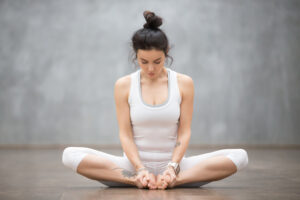 Even if you never work out, there are five stretches you should do every day to preserve mobility and prevent back pain. Simple changes each day can be very beneficial to your body and overall health. Continue reading to find out what stretches you should be doing every day!
Even if you never work out, there are five stretches you should do every day to preserve mobility and prevent back pain. Simple changes each day can be very beneficial to your body and overall health. Continue reading to find out what stretches you should be doing every day!
Stretching can feel like a real hassle, but it really is crucial to preventing injury and maintaining a good range of mobility—especially if you’re engaging in serious weight training. You should always throw some basic stretches into your pre- and post-workout, do what feels good, and talk to a doctor if something hurts in more than an “oooh yeah, that’s the stuff” kind of way.
But just because stretching is a core pillar of fitness doesn’t mean it comes naturally to everyone who works out. Even if you don’t work out, you should still be stretching. We talked to two of our favorite fitness and mobility experts to find out which stretches are crucial for everyone.
What parts of the body are most in need of attention?
For people who don’t get much physical activity in—or just don’t pay much mind to stretching—hips are an important place to start limbering up.
“Having mobility in your hips is important for decreasing and preventing lower back pain,” says Mike Watkins, a licensed athletic trainer. “Shakira said it best when she said ‘hips don’t lie.’”
Lauren Leavell, a NASM Certified Personal Trainer, agrees that a sore, achy back is a common complaint that increased flexibility can help improve. “[Back pain] can be from posture, your chair at work, and underworked muscles,” she says. Focusing on the back, hips, and shoulders can make a world of difference when it comes to decreasing everyday aches.
What are the basic stretches everyone should try to do?
Adding stretching to your day doesn’t have to mean squeezing an hour of advanced yoga flows in your schedule. Here are a few simple moves that anyone can fit into their daily routine:
Neck and shoulder rolls: Slowly rolling your neck in one direction, then the other, is a simple but effective way to relax some of your stiffest muscles. When you’re done, move on to rolling your shoulders forward and backward.
“They may seem simple, but these are really good for relieving stress and tension in the body,” Watkins says. “Most people hold a lot of tension in their shoulders, and rolling them out really helps release it.”
Forward folds: Even if you can’t touch your toes, folding your body forward is a great move for loosening up your back. There are a few ways you can go into a fold: You can stand up and dive with your upper body toward the ground, sit down with your legs in front of you and reach towards your heels, or even just bend forward in your office chair. Make sure you’re folding at the crease of your hip instead of hunching your back. While all three options target the back, Leavell says, the standing version of the stretch also benefits the backs of your legs.
Kneeling hip flexor stretches: Tight or injured hip flexors can cause pain in your back, your knees, and pretty much everywhere in between. Watkins recommends a kneeling stretch as an easy and effective way to keep those flexors loose and happy. After placing down a yoga mat or a folded towel to protect your knee, kneel on the side you want to stretch and step the other leg out in front of you (see an example here). Keep your back neutral and your pelvis tucked in, then slowly lunge forward until you feel a nice stretch. You can either hold it for 30-60 seconds or pulse into and out of the stretch every few seconds for the same length of time. Repeat on the other side, and stop if you feel any lower back pain or pinching.
Butterfly poses: You might be intimidated by yoga practitioners who seem comfortable in an extreme version of this pose, but Leavell says it’s great for beginners looking to stretch their hip flexors, inner thighs, and back. Sit on the floor with your feet together and knees apart. If the pose is new to you, Leavell says, don’t worry about making the stretch very deep—you can move your feet further away from your body to make things easier, and stay seated straight up. For more intensity, she says, start to bring those feet closer and fold forward. “Your seat should stay grounded, and you should take long, deep breaths,” Leavell says.
Behind the back chest openers: Leavell recommends this move for releasing tension in your shoulders and back. You can do it either seated or standing, all you need to do is bring your arms behind your back, interlace your fingers, and pull your shoulders back to stretch your arms backward.
How much time should you devote to stretching?
When it comes to holding individual stretches, Watkins recommends aiming for 15-60 seconds per movement. Even if that feels a bit long when you first start out, it’s crucial not to pop out of a stretch too quickly unless you’re about to hurt yourself. Give it at least six solid seconds. As PopSci’s Claire Maldarelli wrote on her quest to finally touch her toes, giving up too quickly can keep you from enjoying the stretch your body is truly capable of:
Your muscle groups contain cells called muscle spindles. Whenever you stretch a muscle, these sensory receptors tell neurons within the muscle to fire a signal back to the central nervous system through the spinal column. This causes your muscles to contract, tighten, and resist the force to be stretched, resulting in that annoyingly painful feeling that most of us get when we first reach down to touch our toes or attempt to stretch other muscles. However… if you are patient, this too shall pass.
As for stretching frequency, Leavell says, these are all moves that can be done multiple times a day. “For folks spending a large amount of time at their desks, it would be great to do these on a short five-minute break just to get the body moving,” she says. “The most important thing to remember is that consistency is key. Whether you are doing five minutes or an hour of stretches per day, the progress comes from consistently showing up.”
What if these stretches are too difficult?
The poses outlined above are a good place to start for most, but everyone is different and your results may vary. The most important thing is to not force your body into shapes that hurt.
“It’s okay to feel a little tingling when you stretch, but there should never be pain,” Watkins says. Ideally, stretching should be relaxing—and feel good. So if the poses outlined above sound out of your reach, take things slow.
“Try them, adjust them, and try them again,” Leavell says. “So many stretches can be modified or swapped to accommodate individual needs.” Modifications that might include different movements or tools are easy to find online, and you don’t need special props to accomplish them—Leavell recommends using books instead of yoga blocks, robe ties instead of yoga straps, and pillows in place of bolsters.
“Take your time and do what feels good for your body,” Watkins says. “Only you know what’s right.”
If you feel like you’re ready to add more stretches into your routine but don’t know what to do next, consider taking an in-person or virtual stretching class with a fitness instructor. If holding even simple stretches causes some serious discomfort, seeing a physical therapist is a good first step.
Original and complete article published on popsci.com







